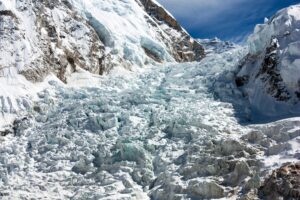Few items can claim to have reached both the bottom of the deepest ocean and the upper reaches of the highest mountain. But in a sad sign of human impact on the natural world, scientists have recently discovered microplastics at 8,400m on Mount Everest.
The research, published last month, aimed to identify and characterize microplastic pollution near the top of Everest and to illustrate the implications for the environment and those living below.
Microplastics are small plastic fragments up to 5mm long. They are either already smaller than 5mm when they enter the environment, or they were originally larger plastics, which break down to become microplastics.
Microplastics often come from everyday plastic items such as water bottles. An estimated 15 to 51 trillion individual pieces of microplastic litter the world’s oceans, weighing up to 236,000 metric tons.
The microplastics on Everest combined polypropylenes, polyester, acrylic and nylon, materials typically used in the technical gear, such as clothing, tents and ropes, that climbers require on expeditions.
It’s possible that microplastics blew atop Everest from cities below, but since larger quantities were found in the areas of human activity, such as the standard route up the mountain, it is more likely that they came from items used by humans.
Everest Base Camp itself had 79 microplastic fibres per litre of snow; at the Balcony, 10 microplastics fibres per litre. The highest altitude where researchers managed to take samples was at 8,440m. Here, they found 12 microplastics per litre of snow.

Environmental scientist Imogen Napper helped discover microplastics on Everest. She suggests creating plastic-free technical clothing. Photo: Plymouth University
Imogen Napper, a marine scientist from the University of Plymouth who is currently working with National Geographic, was one of the key researchers on the Everest project. Her work on plastics in oceans has highlighted the omnipresence of this sort of pollution. One of her particular areas of study shows how microplastics in clothing make their way into our waterways.
“The most surprising bit for me was looking at the sample from the Balcony,” Napper said. “That means we’re finding plastics in the deep sea all the way to near the top of the tallest mountain on Earth.
Earlier this year, scientists had discovered a new species of shrimp six to seven kilometres down in the Pacific Ocean’s Mariana Trench, the deepest waters on Earth. They named the species Eurythenes plasticus after finding microplastics present within the species, the deepest known occurrence of microplastics.
On Everest, Napper and her colleagues collected eight 900-millilitre samples of stream water and 11 300-millilitre samples of snow from different points on the mountain. Microplastics were present in all of the snow samples and three of the stream samples.
“Even though the research on Mount Everest was really exciting, you are secretly hoping not to find any [plastics] because you want the environment to be pristine,” says Napper.
Trekkers can unintentionally shed microplastics from their clothes even by walking for 20 minutes or opening a plastic bottle.

Because it can take 100 years or more for plastics to break down, it is not yet known the effect that microplastics will have on an environment like Everest. The effect on human health is also unclear.
Research has shown, however, that wildlife can ingest microplastics, one major area of concern. Microplastics have even turned up in the bodies of Antarctic penguins. One expert called microplastics “the 21st century’s asbestos”.
Asbestos was used as a building material for years. Hailed as a highly heat-resistant insulator, it wasn’t until years later that it became clear how damaging it is. Particles released into the atmosphere become poisonous, causing cancer when inhaled. Plastic is a relatively new material, which in its 100 years has already created a global problem.
Now that microplastics are present on Everest, the question is how we responsibly prevent quantities from increasing. Cleaning up what is already present doesn’t stop more more from arriving.
One possible solution could be to “start designing clothes that are woven differently to shed fewer fibres,” Napper suggests. “It’s like a trail of breadcrumbs: Where people go, they are leaving a trail of microplastics.”






